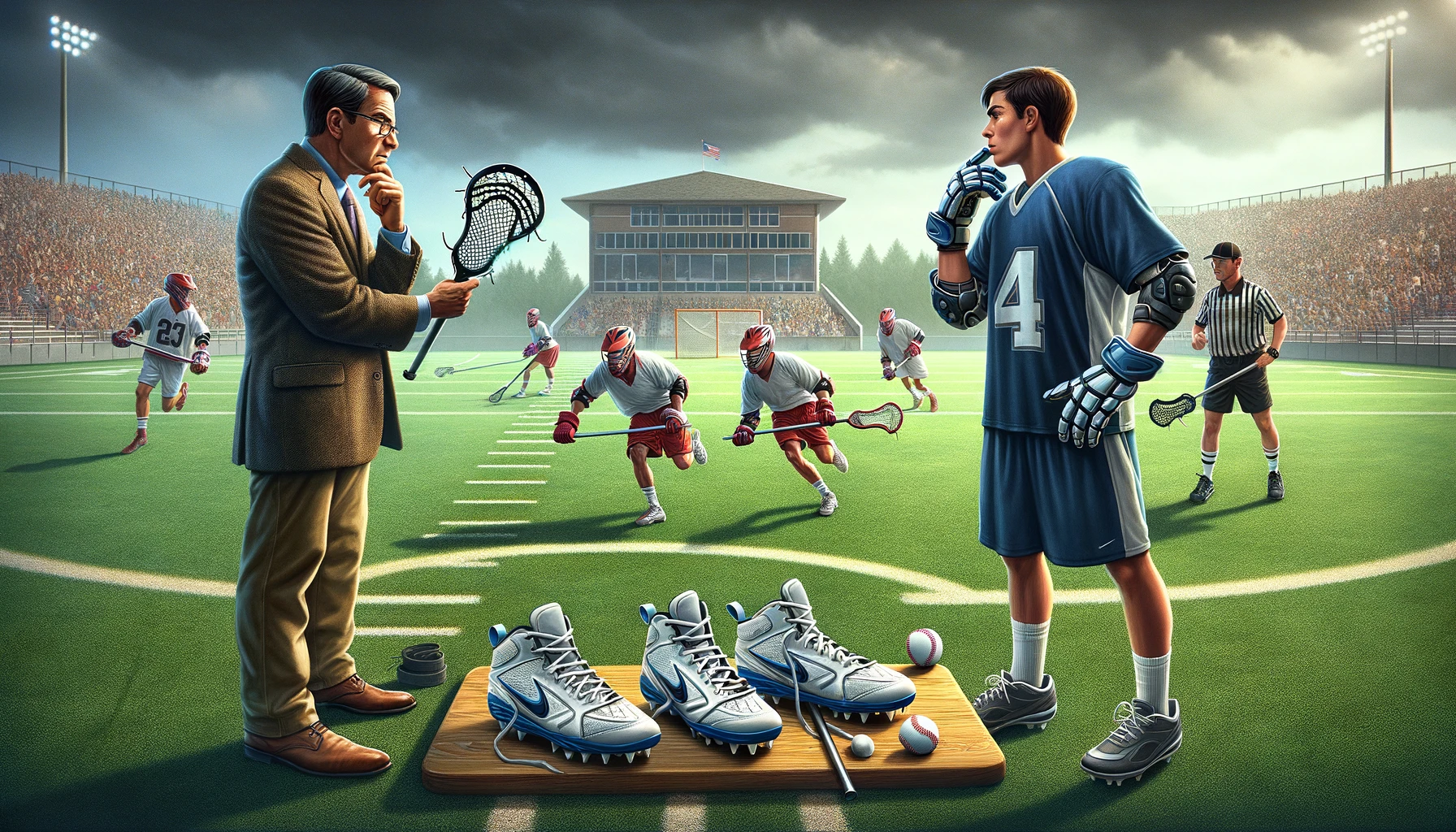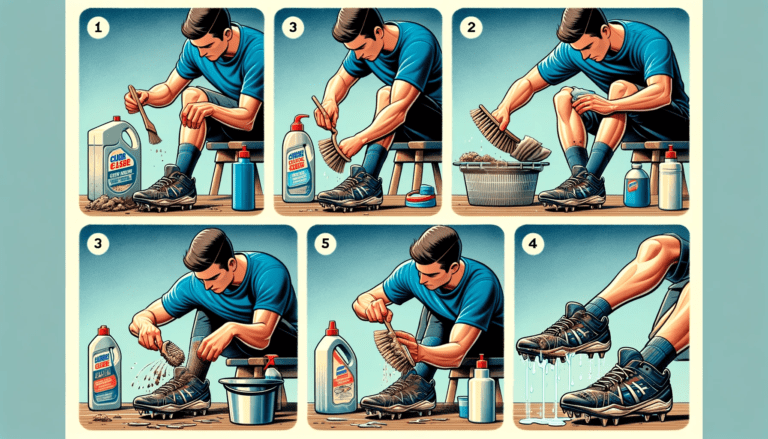Can You Wear Baseball Cleats for Lacrosse?
When it comes to sports gear, picking the right pair of shoes is key. You might be wondering if your baseball cleats can double up for a game of lacrosse.
The short answer is yes, you can wear baseball cleats for lacrosse, but there’s a bit more to consider. While these cleats offer the grip and support needed for the field, lacrosse demands specific features in footwear for the best play.
In this article, we’ll explore what works and what doesn’t when using baseball cleats for lacrosse, helping you make a smart choice for your game.
Key Takeaways
- Baseball cleats can be worn for lacrosse, but they differ in design and construction, potentially affecting performance and safety.
- Lacrosse cleats are typically more flexible and offer better lateral support, crucial for the sport’s demands.
- Players must consider league requirements and safety standards when choosing cleats for lacrosse to avoid penalties.
- Professional insights suggest that lacrosse-specific cleats provide optimal performance, stability, and protection.
- Exploring alternatives such as lacrosse-specific, soccer, or football cleats can lead to improved comfort and gameplay.
Understanding the Differences: Baseball vs. Lacrosse Cleats
Cleat Shape and Design
The design of cleats is pivotal in defining their suitability for different sports. Baseball cleats often feature a prominent toe spike, which aids players in gaining traction during quick sprints and abrupt stops.
This is particularly useful when digging into dirt surfaces. In contrast play soccer, lacrosse cleats lack this toe spike as the sport demands more lateral movement and agility.
Cleat patterns also vary significantly between the two sports:
- Baseball cleats have a focused spike pattern tailored for linear sprints and stopping.
- Lacrosse cleats boast evenly distributed spikes to enhance grip and facilitate the multi-directional movement required in lacrosse.
These differences in cleat shape and design are not just aesthetic but functional, impacting a player’s stability and balance during gameplay.
While baseball cleats are optimized for performance on grass and dirt, lacrosse players need footwear that supports the unique demands of their sport, including rapid directional changes and consistent traction on artificial turf and fields.
Material and Construction
The material and construction of cleats play a pivotal role in their suitability for different sports.
Lacrosse cleats are typically designed with additional padding and cushioning to accommodate the demands of prolonged gameplay, which can last up to 60 minutes in college games.
This contrasts with baseball cleats, which often prioritize lightweight materials to facilitate quick movements on the diamond.
When selecting cleats, it’s important to consider several factors:
- The durability and breathability of the material, with leather being a common choice for its robustness.
- The type of sole material, such as rubber, offers superior traction on various surfaces.
- The closure system, like lace-up designs, ensures a secure and adjustable fit.
Moreover, some baseball cleats feature a molded mesh upper with a film for added durability and targeted support, which might not provide the same level of comfort and protection needed for lacrosse.
It’s essential to weigh these aspects carefully to ensure that your footwear will not only enhance your performance but also withstand the specific conditions of your sport.
Ankle Support and Protection
When it comes to ankle support and protection, baseball and lacrosse cleats offer different benefits that cater the shoe made to the specific needs of each sport.
Baseball cleats typically provide a higher cut around the ankle, which can offer additional support for lateral movements and reduce the risk of ankle injuries.
This is particularly important in baseball where quick pivots and side-to-side motions are common.
However, lacrosse players may find that the stiffness and support of baseball cleats can be restrictive.
Lacrosse requires a blend of agility and speed, and too much rigidity can impede a player’s ability to perform quick directional changes. It’s essential to balance support with flexibility to ensure peak performance on the lacrosse field.
- Consider the level of ankle support needed for your position and playing style.
- Evaluate the flexibility of the cleat to ensure it doesn’t hinder movement.
- Look for features like Achilles pads and hybrid tongue construction that offer both support and comfort.
Read Also: Can You Wear Metal Cleats in High School Baseball
Safety Considerations for Lacrosse Players Using Baseball Cleats

Risks of Inadequate Flexibility
When lacrosse players opt for their baseball shoes over cleats, they may encounter risks of inadequate flexibility.
Baseball cleats are designed with shorter studs, which can lead to less stability during the high-speed maneuvers typical in lacrosse. This reduced stability is particularly concerning when players are cutting or changing direction rapidly.
- Less stability due to shorter studs
- Inadequate grip affecting lateral movements
Moreover, the grip pattern on baseball cleats is not optimized for the sport’s lateral and zig-zag movements, potentially compromising performance.
The lack of evenly distributed grip can also increase the risk of injuries, as the cleats are not tailored to the specific demands of lacrosse.
Ensuring that footwear provides sufficient flexibility is crucial to prevent injuries related to decreased dorsiflexion range of motion (ROM), which has been documented as a risk factor for developing several conditions.
Importance of Lateral Support
Lateral support is crucial in lacrosse due to the sport’s dynamic movements, including sharp cuts and side-to-side actions.
Baseball cleats, being more rigid, may not provide the necessary flexibility for these movements, potentially hindering performance and increasing the risk of injury.
Lacrosse cleats, in contrast, are designed with a focus on flexibility and stability to accommodate the sport’s unique demands.
Key considerations for lateral support in cleats include:
- The ability to make quick directional changes without losing stability.
- Adequate protection against ankle rolls during rapid movements.
- Ensuring that the cleats offer a snug fit to support the foot laterally.
It’s essential to choose cleats that cater to the sport’s requirements to maintain safety and optimize performance. Remember, the right footwear can significantly impact your agility and protection on the field.
Ensuring Proper Movement and Comfort
For lacrosse players, ensuring proper movement and comfort is crucial for peak performance.
Unlike baseball cleats, which are designed for the diamond’s dirt and grass, lacrosse cleats must accommodate the sport’s unique demands, including rapid directional changes and extended periods of running.
- Flexibility: Lacrosse cleats should offer a balance of flexibility to allow for agile movements without sacrificing stability.
- Fit: A well-fitting cleat is essential to prevent blisters and discomfort, which can distract from gameplay.
- Cushioning: Adequate cushioning absorbs impact and reduces fatigue, keeping players comfortable throughout the game.
When selecting cleats, consider the balance of comfort, flexibility, and durability based on your position and playing style.
Remember, safety should always be a priority, and the right footwear can significantly improve traction and stability on the field.
Read Also: What Size Baseball Cleats Should I Get
Navigating Rules and Regulations for Cleat Usage in Lacrosse

League Requirements for Footwear
Lacrosse leagues have specific requirements for footwear that players must adhere to for both safety and compliance.
For instance, the Arapahoe Youth League explicitly states that shoes must be designed for lacrosse, and metal spikes are prohibited.
- Shoes designed for lacrosse use are mandatory.
- Metal spikes are not allowed under any circumstances.
Players must check with their respective leagues for any additional footwear regulations. Non-compliance can lead to penalties, ranging from warnings to disqualification from games.
Safety Standards and Compliance
Adhering to safety standards and compliance is crucial for lacrosse players when selecting wear lacrosse cleats now.
Safety regulations are not uniform and can vary significantly from one association to another.
For instance, while some youth leagues only may permit the use of soccer cleats, others have strict requirements tailored to lacrosse footwear.
- It’s essential to be aware of the specific rules set by governing bodies such as the National Operating Committee on Standards for Athletic Equipment (NOCSAE). These organizations establish guidelines to ensure player safety and equipment performance.
- As of January 1, 2022, new safety rules have been implemented, such as the NOCSAE ND200 requirement for shoulder pads. While this particular rule does not pertain to cleats, it underscores the evolving nature of safety standards in youth sports, including lacrosse.
Players and coaches must stay informed about these regulations to avoid penalties and, more importantly, to safeguard the athletes’ well-being during play.
Potential Penalties for Non-Conforming Cleats
When players choose to wear non-conforming cleats, they not only risk their own safety but also face potential penalties from their leagues.
Violations of cleat regulations can lead to several repercussions, including:
- Being barred from participating in the game until proper footwear is worn.
- Receiving a warning or a penalty during a game, which could impact the team’s performance.
- Incurring fines or other disciplinary actions from the league, especially if the non-compliance is recurrent.
It’s essential for players to understand that the enforcement of these rules is not just about conformity, but primarily about ensuring a safe and fair, playing surface and environment for all participants.
Before going on the field, it’s a good idea to ask coaches or league officials if your cleats are okay to use. This can help avoid any problems.
Expert Insights on Selecting the Right Cleats for Lacrosse
Performance Impacts of Cleat Choice
The choice of cleats is a critical factor that can influence a player’s agility, speed, and overall performance on the field.
Baseball cleats are designed with a focused spike pattern, which is optimized for short sprints and sudden stops, a common requirement in baseball.
In contrast to baseball spikes, lacrosse cleats feature an evenly distributed spike pattern that provides the grip and traction necessary for the dynamic movements in lacrosse.
Material and construction also play a pivotal role in performance. Baseball cleats tend to be made with lightweight materials to facilitate quick movements.
However, lacrosse cleats often have more padding and cushioning to offer comfort during the extended duration of lacrosse games. Players should weigh these differences when selecting their footwear.
Ultimately, the decision should be informed by the specific demands of lacrosse and the player’s individual needs.
By understanding the advantages and disadvantages of each type of cleat, athletes can make a choice that enhances their gameplay and aligns with their playing style.
Recommendations from Professional Players and Coaches
When it comes to selecting the right cleats for lacrosse, professional players and coaches often emphasize the importance of choosing footwear that is specifically designed for the sport.
The consensus is clear: lacrosse-specific cleats are the preferred choice for optimal performance.
- Durability and stability are frequently mentioned as critical factors, with many professionals recommending brands known for their high-quality construction, such as the Nike Alpha Huarache 9 Varsity Lacrosse Cleats.
- Attention to traction and flexibility is also advised, as these characteristics can significantly impact a player’s agility and speed on the field.
- It’s not uncommon for seasoned players to suggest trying on multiple pairs to find the best fit, as comfort is paramount for peak performance during games and practices.
Evaluating Cleat Options for Optimal Gameplay
When it comes to selecting the right cleats for lacrosse, players must weigh the advantages and disadvantages of various options.
Baseball cleats are known for their lightweight materials, which are ideal for short sprints and sudden stops.
However, lacrosse cleats typically offer more padding and cushioning, which is crucial for comfort during the prolonged duration of a lacrosse game.
To ensure optimal performance, consider these factors:
- The cleat’s traction and stability, which can significantly affect your agility and speed on the field.
- The material and construction of the cleat, as it impacts durability and foot protection.
- The design of the cleat pattern, which should provide an even distribution of spikes for grip and traction specific to lacrosse movements.
Remember, the right cleat choice can enhance your gameplay, while the wrong one can hinder your performance and even pose safety risks.
Listen to your body and choose footwear that meets the demands of lacrosse, keeping in mind the insights from professional players and coaches.
Read Also: How To Clean Baseball Cleats
Exploring Alternatives: Lacrosse-Specific and Other Cleat Options
Benefits of Lacrosse-Specific Cleats
Lacrosse-specific cleats are tailored to meet the unique demands of the sport, offering several advantages for players.
They are designed to provide optimal grip, traction, and stability, which are essential for the lateral movements and quick changes in direction characteristic of lacrosse.
Here are some key benefits:
- Enhanced traction with a distributed stud pattern suitable for the sport’s common zig-zag running patterns.
- A balance of support and flexibility to accommodate the dynamic nature of lacrosse.
- Stiffer construction compared to other sports cleats, which aids in preventing ankle rolls and injuries.
Choosing lacrosse-specific cleats can significantly impact your performance on the field. They are engineered to cater to the sport’s requirements. Ensuring that players have the necessary support and comfort throughout the game.
While other types of cleats may be used, lacrosse-specific options are the best choice for players looking to maximize their effectiveness and safety on the field.
Comparing Soccer and Football Cleats for Lacrosse Use
When considering alternatives to baseball cleats for lacrosse, soccer and football cleats emerge as viable options.
Soccer cleats are known for their low-cut design and lightweight construction, which provide increased agility and a closer feel of the ball. However, they may lack the necessary ankle support for the physicality of lacrosse.
On the other hand, football cleats offer a different set of advantages. They typically feature a mid or high-cut design, enhancing ankle support, which is beneficial during the intense lateral movements of lacrosse.
The studs on football cleats are also evenly distributed, similar to those on lacrosse cleats, supporting the sport’s multidirectional movement.
In choosing between soccer and football cleats for lacrosse, consider the following:
- The level of ankle support you require
- The importance of agility and speed in your position
- The type of field surface you will be playing on
Ultimately, the decision should align with your personal comfort and performance needs on the field.
Making the Best Footwear Decision for Your Game
Selecting the right cleats for lacrosse is not just about style or brand preference; it’s about enhancing your performance on the field and ensuring your safety. Here are some steps to guide you through this crucial decision:
- Evaluate the cleat design and how it affects your movement and traction during play.
- Consider the material and construction of the cleats for durability and comfort over long periods.
- Assess the level of ankle support provided, which is vital for preventing injuries.
Remember, while lacrosse-specific cleats are designed for the sport’s unique demands, other types of cleats like soccer or football cleats might also be suitable alternatives.
Weigh the advantages and disadvantages of each option and consult with coaches or experienced players if possible.
Ultimately, the best decision is one that aligns with your playing style, the sport’s requirements, and your personal comfort.
Conclusion
In conclusion, while baseball cleats can technically be worn for as dedicated lacrosse cleats, it is important to consider the specific design and performance features that differentiate them from lacrosse cleats.
The rigid construction and lateral support of baseball cleats may not offer the flexibility and ankle protection needed for dynamic movements in lacrosse. Weighing the pros and cons, as well as prioritizing safety and comfort, is crucial.
Ultimately, investing in lacrosse-specific cleats or exploring other suitable alternatives, such as soccer or football cleats, is advisable to ensure optimal performance and protection on the field.
Always consult your league’s regulations and choose footwear that aligns with your playing style and needs.
Frequently Asked Questions
Can I use baseball cleats for lacrosse?
Yes, you can wear baseball cleats for lacrosse if they meet the necessary safety requirements, but you should consider the differences in design and how they may affect your performance.
What are the main differences between baseball and lacrosse cleats?
Baseball cleats are generally more rigid with a design optimized for short sprints and sudden stops. On the other hand, lacrosse cleats are more bendy. They’re built for moving side to side. Plus, they often have extra padding around the ankle.
Are there safety concerns when using baseball cleats for lacrosse?
Yes, wearing baseball cleats for lacrosse could lead to inadequate flexibility and lateral support, which may affect movement, comfort, and overall safety on the field.
Do lacrosse leagues have specific rules for cleat usage?
Most lacrosse leagues have footwear requirements that players must adhere to, which include safety standards and compliance with equipment regulations.
What do experts recommend regarding cleat selection for lacrosse?
Experts generally recommend choosing cleats specifically designed for lacrosse to maximize abilities and comfort during gameplay, although baseball cleats can be a temporary alternative.
Are there any suitable alternatives to baseball cleats for lacrosse players?
Yes, lacrosse-specific cleats, as well as soccer and football cleats, can be good alternatives. They offer benefits that can make playing lacrosse more comfortable. They also provide better support and can help improve how you play.







